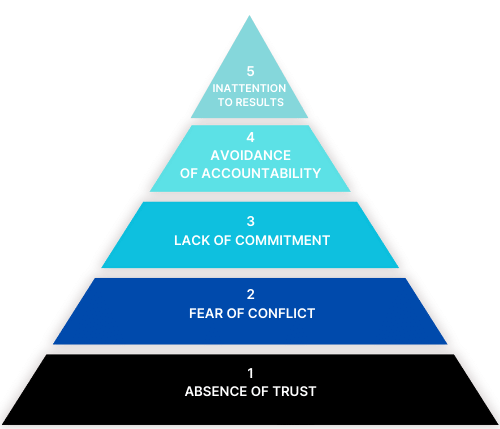Table of Contents
ToggleIf you could get all the people in an organization rowing in the same direction, you could dominate any industry, in any market, against any competition, at any time.
This is the central theme of this book emphasizing teamwork as the key to successful project outcomes. While building a cohesive team may be difficult, it is not impossible.
“The Five Dysfunctions of a Team”, a business book by Patrick Lencioni, explores team challenges that hinder a team’s effectiveness and it offers practical strategies for overcoming them. This book provides team leaders and managers with the necessary tools to build a cohesive team.
Lencioni outlines a model that identifies Five interrelated Dysfunctions that can disrupt a team’s effectiveness and provides actionable practical strategies that can be applied to improve team dynamics.

The FIVE DYSFUNCTIONS of a team:

Absence of Trust
This is the foundational dysfunction. Teams struggle when members don’t trust each other. This lack of trust prevents open communication, sharing of ideas, and collaboration, leading to a lack of vulnerability and support among team members. Team members are unwilling to be vulnerable with one another, which prevents them from sharing their weaknesses and mistakes. A lack of trust leads to guardedness and inhibits open communication.

Fear of Conflict
Without trust, teams avoid healthy conflict and debate. This fear of conflict leads to artificial harmony where issues are not addressed, resulting in unresolved problems and poor decision-making. Teams that lack trust tend to avoid conflict. This avoidance stifles productive debate and can result in unresolved issues and resentment.

Lack of Commitment
When teams don’t engage in open discussions and/ or some level of conflict, they struggle to commit to decisions. This lack of commitment means members are not fully invested in achieving team goals, leading to ambiguity and low accountability. When teams do not engage in open discussions, members may not feel fully invested in decisions.

Avoidance of Accountability
Teams that lack commitment struggle with holding each other accountable. This avoidance results in lower performance standards and unmet goals, as members are reluctant to confront each other about failures. Without commitment, team members are less likely to hold each other accountable for their actions. This can result in low standards and a culture where poor performance is tolerated.

Inattention to Results
When team members don’t hold each other accountable, they focus on personal goals rather than collective results. This inattention to team goals impacts overall performance and the achievement of objectives. Finally, when team members prioritize personal success over collective goals, the team's overall performance suffers. This dysfunction can erode the focus on achieving shared objectives.
Lencioni offers Actionable practical strategies for overcoming each dysfunction :
Absence of Trust:
- Personal Histories Exercise: Encourage team members to share personal stories and experiences to build a foundation of trust.
- Behavioral Profiling: Use tools like the Myers-Briggs Type Indicator (MBTI) or DiSC assessment to help team members understand each other’s personalities and work styles.
- Leader’s Vulnerability: Leaders should model vulnerability by admitting their mistakes and weaknesses, setting a precedent for the rest of the team.
Fear of Conflict:
- Mining for Conflict: Leaders should actively seek out and address areas of disagreement to ensure healthy conflict occurs.
- Real-Time Permission: During meetings, remind team members that conflict is necessary and productive.
- Conflict Resolution Training: Provide training on how to engage in constructive conflict and resolve disputes effectively.
Lack of Commitment:
- Cascading Messaging: At the end of meetings, review and agree on key decisions and next steps, ensuring everyone is on the same page.
- Deadlines and Clarity: Seek consensus Set clear deadlines and expectations for tasks and projects.
- Worst-Case Scenario Analysis: Discuss potential risks and outcomes to help team members commit to decisions with a better understanding of implications.
Avoidance of Accountability:
- Publication of Goals and Standards : Make goals and standards public to increase accountability.
- Simple and Regular Progress Reviews: Hold regular progress reviews where team members report on their commitments and hold each other accountable.
- Peer Accountability: Encourage team members to hold each other accountable, not just rely on the leader to enforce standards.
Inattention to Results:
- Results-Based Rewards: Tie rewards and recognition to the achievement of team goals rather than individual accomplishments.
- Scoreboards and Metrics: Use visible scoreboards and metrics to track team progress towards goals.
- Team-Based Objectives: Focus on collective outcomes and ensure everyone understands and is committed to the team’s overall objectives.
Summary
“The FIVE DYSFUNCTIONS of a Team” offers insights into team dynamics and provides a framework for understanding and addressing common issues in teamwork. Its accessible style and practical approach make it a useful resource for managers, team leaders, and anyone looking to build stronger, more cohesive teams, leading to faster project completion, higher employee satisfaction, and reduced project costs.
Read our earlier post, which outlines how to become a more effective leader and enable people around you to realise their full potential, in case you missed it.
